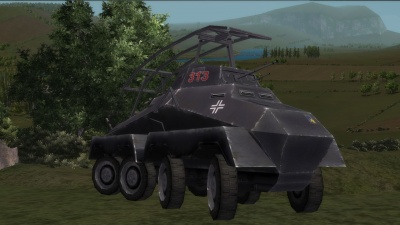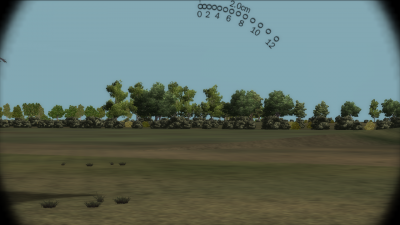SdKfz 232
SdKfz 232 (8-Rad)

| |
| SdKfz 232 / 8Rad | |
| Specifications | |
| Type | Armored Scout Car |
| Armament | Main gun: 2cm Kw.K. 30 L / 55 Coax MG: 7,92mm MG34 |
| Crew | 1 driver, 1 commander, 1 gunner |
| Weight | 7,590kg |
| Top Speed | 83km/h |

| |
| Main Gun Optics | |
| Specifications | |
| Designation | TZF 6 |
| Magnification | 2.4x |
| Field of View | 22° |
History
Germany produced a range of vehicles that filled the role of Schwerer Panzerspähwagen (Heavy Armored Reconnaissance Vehicle), starting with the six-wheeled SonderKraftfahrzeug (Special Motor Vehicle; SdKfz) 231.
In 1929, the Heerswaffenamt (Army Weapons Department) issued specifications for an armored car based on a six-wheeled truck chassis with rear four-wheel drive. In 1932, the authorities approved production from a number of manufacturers. The vehicles had two wheels per axle supported on longitudinal leaf springs. A second driver position was added in the rear, facing backward.
The vehicle was armed with a 2cm Kw.K. 30 L / 55 autocannon and a MG 13 machine gun in a aula turret and was protected by sloped 8mm armor. It carried a FuG Spr Ger A radio with pole aerial, which had a range of 3 km when stationary.
The SdKfz 232 was the Schwerer Panzerspähwagen (Fu), a SdKfz 231 with a more powerful radio. The obvious difference is the huge frame antenna that spread above the vehicle - often called a bedframe antenna for obvious reasons. The antenna served a FuG 11 SE 100 100-watt radio that had a range of 50 km or more. The (Fu) in the official designation identifies the type as a radio carrier. The antenna attached to the turret with a rotating tripod joint that let the turret traverse 360°.
By 1934, the German Army recognized a need for improved cross-country performance, which led to the development of eight-wheeled versions of the 231, 232, and similar variants - designated 8-Rad (8-Wheeled). The vehicles also adopted the MG 34 as the turret machine gun. Production of the 231 and 232 (8-Rad) replaced the six-wheeled version in 1937, although both six and eight-wheeled types would fight in the upcoming World War. All types received a badly needed armor upgrade, and later versions had the 2cm KwK 38 L/55 gun.
When introduced, the 231 and 232 (8-Rad) were the most sophisticated wheeled vehicles in the world, with full-time eight-wheel drive and eight-wheel steering, fully independent suspension, and the rear-facing driver for quick reverse escapes. They were widely used for both long-range reconnaissance and as command vehicles. The platform made for a series of successful support and reconnaisance vehicles, which proved their versatility with a number of variants - including the SdKfz 233 Stummel (Stub) with the same short 7,5cm Kw.K. 37 L / 24 cannon as the PzKpfw IV Ausf. D and StuG III Ausf. B, and the famed SdKfz 234/2 Puma with a 5cm Kw.K. 39/1 L / 60 gun.
Production of the 231 and 232 would continue into 1942. Same late 232s received a rod aerial instead of the frame. The platform's basic design, a multi-wheeled armoured car with a light-caliber rapid-fire gun in a turret, lives on as the guiding principle of most modern light infantry combat vehicles.
Game Play
The 232 remains an exceptionally fast and mobile vehicle in Battleground Europe, although its top heaviness makes it a little hard to handle. Be careful on curves and crossing steep slopes, for it will roll easily. Its speed, even cross country, means that any hard-pressed town can be reinforced with swarms of 232s from undepleted bases even two or three towns distant.
Despite its light armor, the 232 can be infuriatingly hard to kill. So much of that armor is steeply sloped, and the vulnerable components are widely dispersed inside. If a penetrating AP round doesn’t hit crew, engine, gun, or ammunition storage, it can pass through the vehicle doing no functional damage. The 232 tends not to brew up, and many disabled 232s absorb more enemy shells than they should because enemy gunners often don't recognize the extent of the damage they have done.
When using the 232 for reconnaissance, remember to turn slightly to the right of your objective when you stop to view a subject. The thick forward antenna post can block the commander’s view at full binocular magnification. The suspension on the 232 is excellent, and firing at even top speed cross-country is effective. The antenna is ignored in collision detection, so don’t be afraid to drive under low-hanging branches.
Remember that both your rooftop antenna and engine noise are very distinctive. It’s wise to position yourself so that the antenna doesn’t poke above the terrain.
The 232 is avialable from tier 0.
Armor
| Location | Thickness | Angle |
|---|---|---|
| Hull front | 8+10 mm | 30° |
| Hull sides | 8 | 37° |
| Hull rear | 10 mm | 20° |
| Hull top | n/a | n/a |
| Superstructure front | 8+10 mm | 45° |
| Superstructure sides | 8 mm | 40° |
| Superstructure rear | 10 mm | 20° |
| Superstructure top | 5 mm | 83° and 71° |
| Turret front | 8 mm | 25° |
| Turret sides | 8 mm | 28° |
| Turret rear | 8 mm | 30° |
| Turret top | 5 mm | 88° and 78° |
| Gun mantlet | 15 mm | 25 |